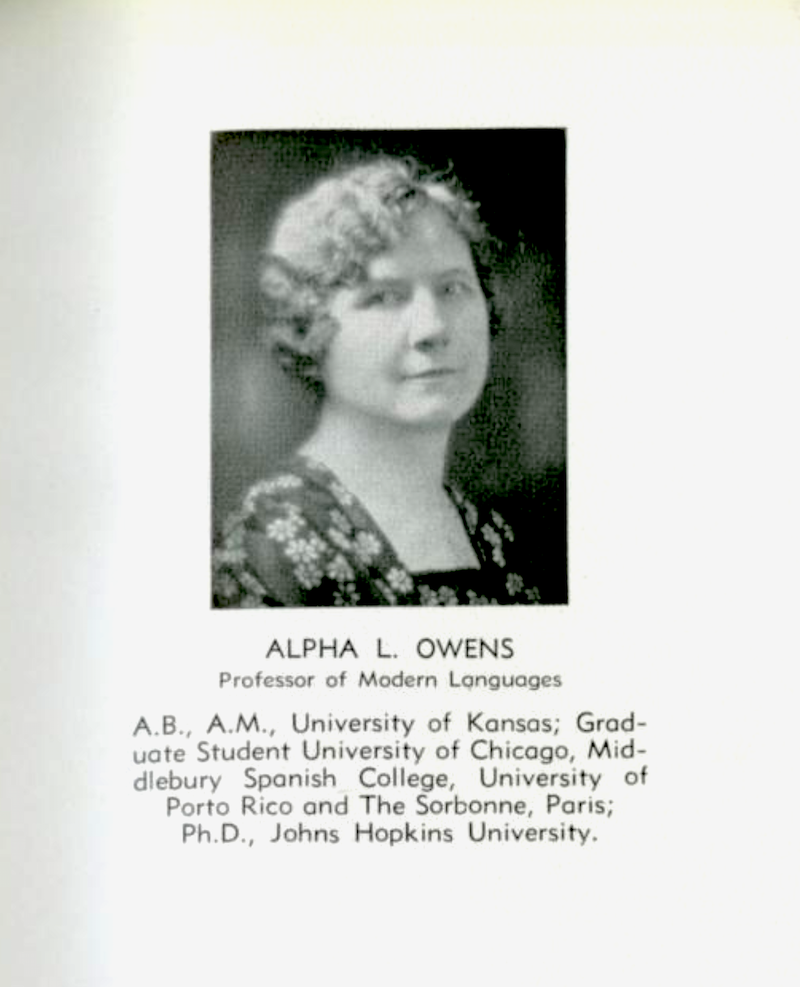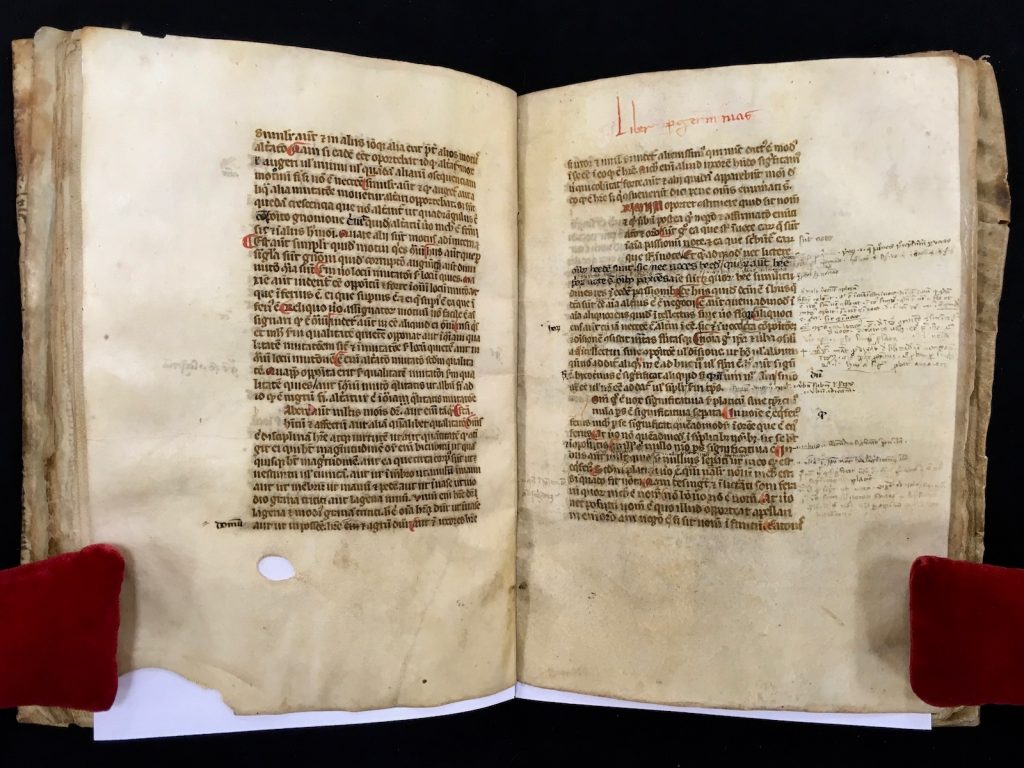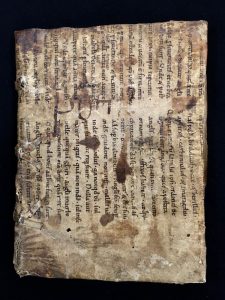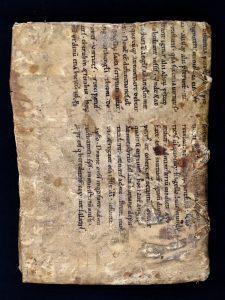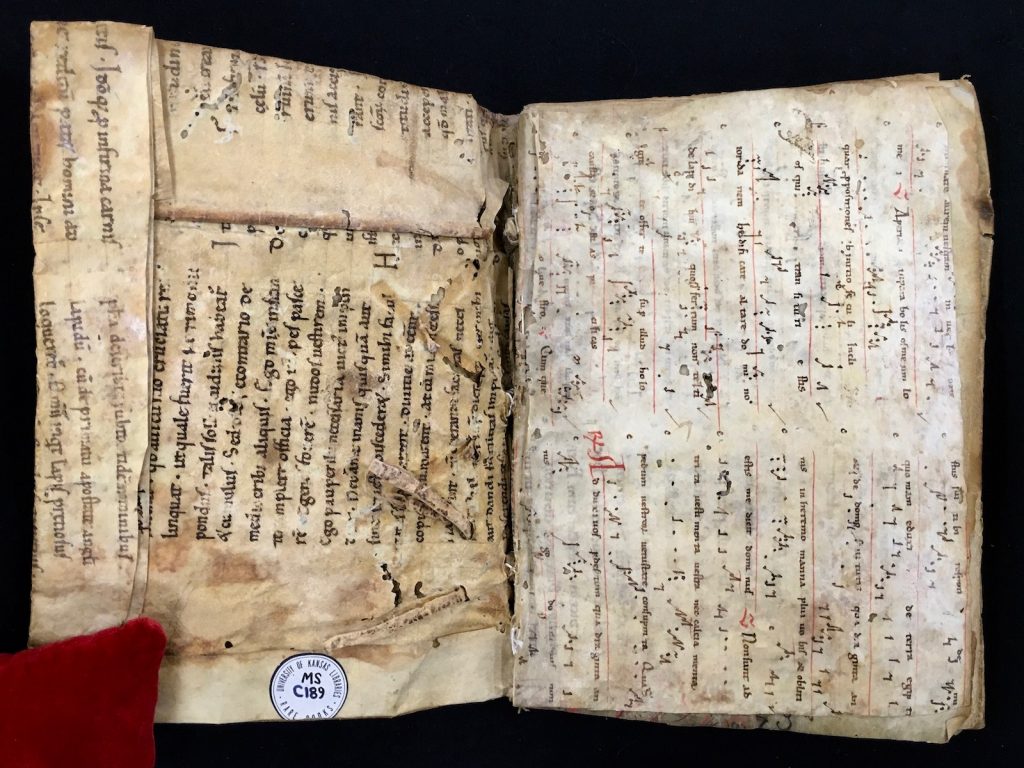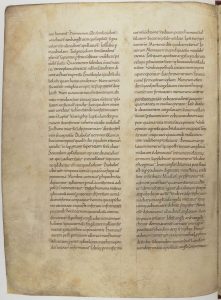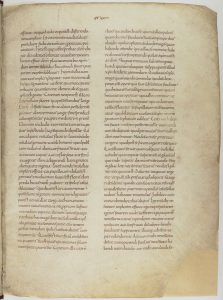Manuscript of the Month: To Transcribe, or Not To Transcribe, That is Not the Question
July 28th, 2020N. Kıvılcım Yavuz is conducting research on pre-1600 manuscripts at the Kenneth Spencer Research Library. Each month she will be writing about a manuscript she has worked with and the current KU Library catalog records will be updated in accordance with her findings.
Kenneth Spencer Research Library Pryce MS P4 has received renewed attention in the past weeks as we ventured into an international transcription competition: “La Sfera Challenge.” The “International La Sfera Challenge” involves transcribing multiple copies of a single text, Gregorio (Goro) Dati’s La Sfera. There are over 150 surviving manuscripts containing this fifteenth-century geographical treatise in Italian, and one of these is Pryce MS P4. During the first iteration of the challenge earlier this year, three different manuscripts were transcribed, and the second, ongoing at the time of the publication of this blogpost, will add to that count five more manuscripts, including Pryce MS P4. The project is supported by the IIIF Consortium, FromThePage and Stanford Libraries, and the transcriptions of all the manuscripts and other related scholarly products resulting from the “La Sfera Challenge” are being made available open access to scholars and the general public. Led by Laura Ingallinella, Karen Severud Cook and myself, Team Spencer consists of a group of ten scholars from across Europe and the US with different fields of expertise who are set to transcribe Pryce MS P4.
Transcribing a manuscript text is a great way to gain insight into the making of a manuscript and the different stages of copying and illumination. It is a very intense process in which one needs to consider carefully every single mark left on the leaves and its potential implications not only for the meaning of the text but also for the production of the artifact. This is particularly true for manuscripts for which we do not have a lot of information, such as Pryce MS P4: neither the scribe nor the place or the date of production is known. A collaborative transcription effort, such as the “La Sfera Challenge,” allows us to discover more about a manuscript, especially compared to a solitary exercise, as there is more than one person asking similar questions and a group of transcribers discussing what is on the page.
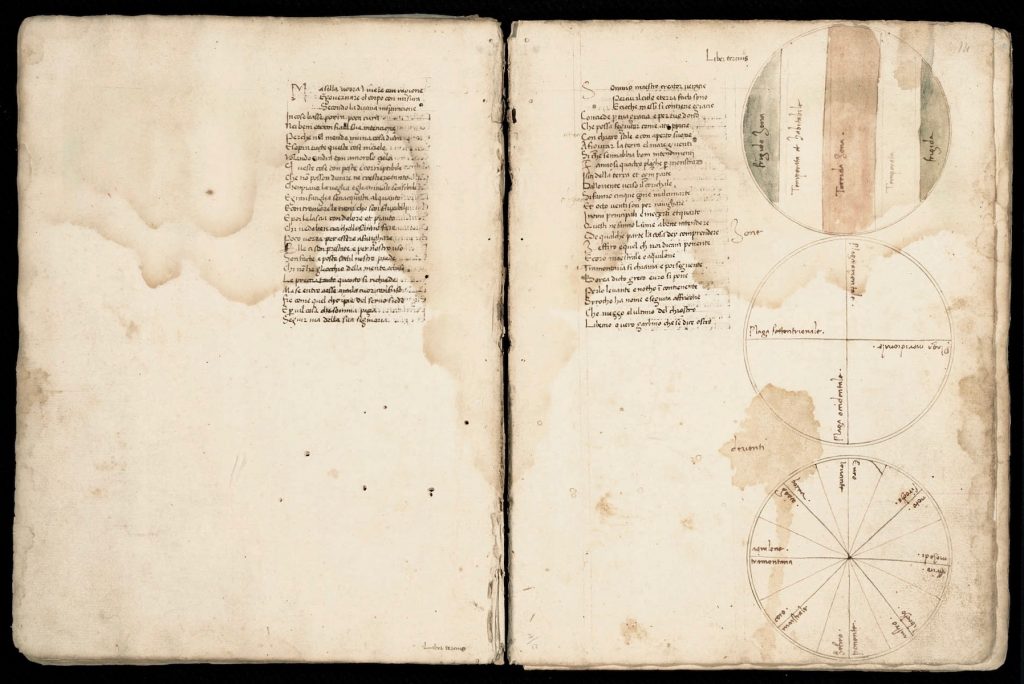
The text of La Sfera is constructed very methodically: it contains four books, with each book containing 36 stanzas and each stanza containing eight lines. In most cases, this even spread of the total 144 stanzas over four books enabled scribes to create uniform-looking layouts when copying the text. La Sfera is found on fols 2r–25r in Pryce MS P4, in two gatherings, both of which are composed of 12 leaves. Each folio contains 24 lines; i.e., three stanzas. Book I occupies fols 2r–7v, Book II fols 8r–13v, Book III fols 14r–19v and Book IV fols 20r–25r. However, only the beginnings of Book II and Book III are signaled in the manuscript on the upper margins of fol. 8r and fol. 14r respectively. Therefore, if there was no comparative material, one would easily think that there were only three books. The omission of the division between the third and fourth books occasionally also occurs in a number of other manuscripts of La Sfera. Furthermore, in Pryce MS P4 Book IV is missing three stanzas: it begins on fol. 20r, which contains stanzas one to three and then on fol. 20v it continues with the seventh stanza, while skipping the fourth, fifth and sixth stanzas.
How the books and chapters of a text are divided or whether there are any missing or additional parts of text are the kinds of peculiarities that enable scholars to make connections between different manuscript copies of a certain text. These kinds of alterations from one manuscript to the other can help determine, for example, whether or not a manuscript might have been copied from another existing manuscript, or whether two manuscripts might be related in some other way. Since the text continues from one side of the leaf to the next in Pryce MS P4, loss of a leaf for the missing stanzas is out of the question. Either the scribe got distracted or misremembered where they left off and began copying the seventh instead of the fourth stanza, or their exemplar—the manuscript from which they were copying—was also missing these three stanzas. There is no indication in the manuscript that the scribe or later readers spotted that there were missing stanzas; indeed, this is one of the things that was hitherto unnoticed about the copy of La Sfera in Pryce MS P4. Thus, in Pryce MS P4, each book occupies six leaves, with the exception of the last one, which is copied on five and a half leaves with the verso of the final leaf (fol. 25v) left blank.
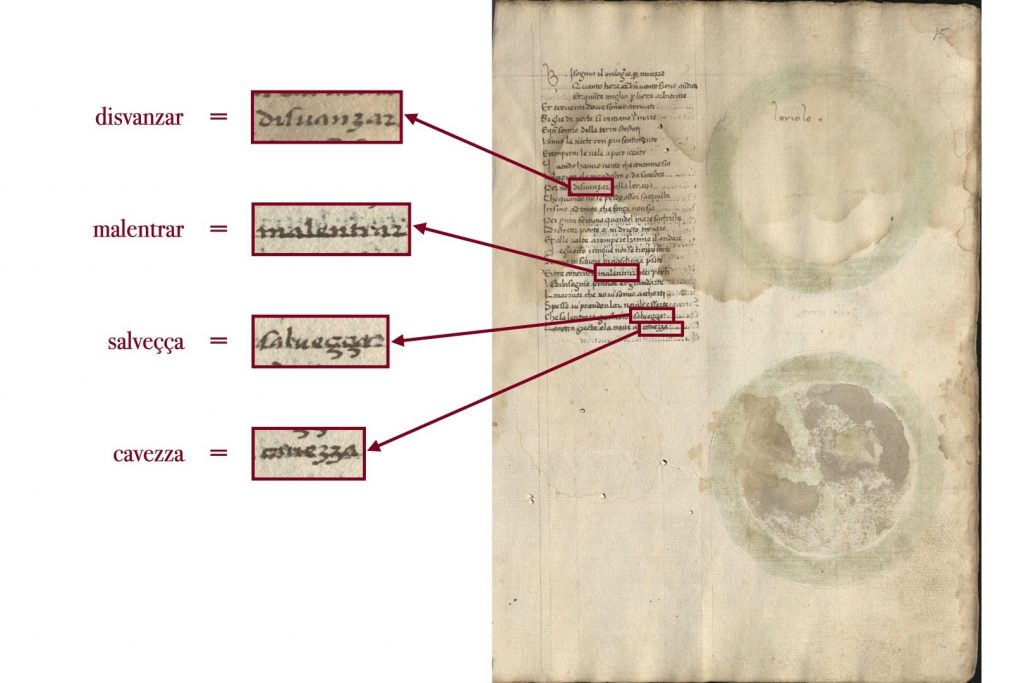
The text of La Sfera in Pryce MS P4 is not given a title nor is it attributed to an author. The main text was copied by a single scribe. Since we do not know the identity of the scribe or exactly when and where they might have copied the manuscript, a detailed examination of any distinguishable textual and scribal features becomes very important. An interesting paleographical and orthographical feature in Pryce MS P4 is that the scribe uses two different letterforms for the letter r as well as two different letterforms for the letter z. Whereas the use of two different letterforms for the letter r might be due to scribal practices of the times, the different letterforms for the letter z are almost certainly due to the different phonetics of the words, even though they are both represented with the letter z in modern Italian. When pronounced unvoiced, the letter z produces the “ts” sound and when voiced, the “dz” sound. Therefore, for example, we have decided to distinguish between the two different letterforms used for the letter z in the manuscript and represent these as “ç” (for “ts”) and “z” (for “dz”) in our transcription, which can now be viewed in full on FromThePage.
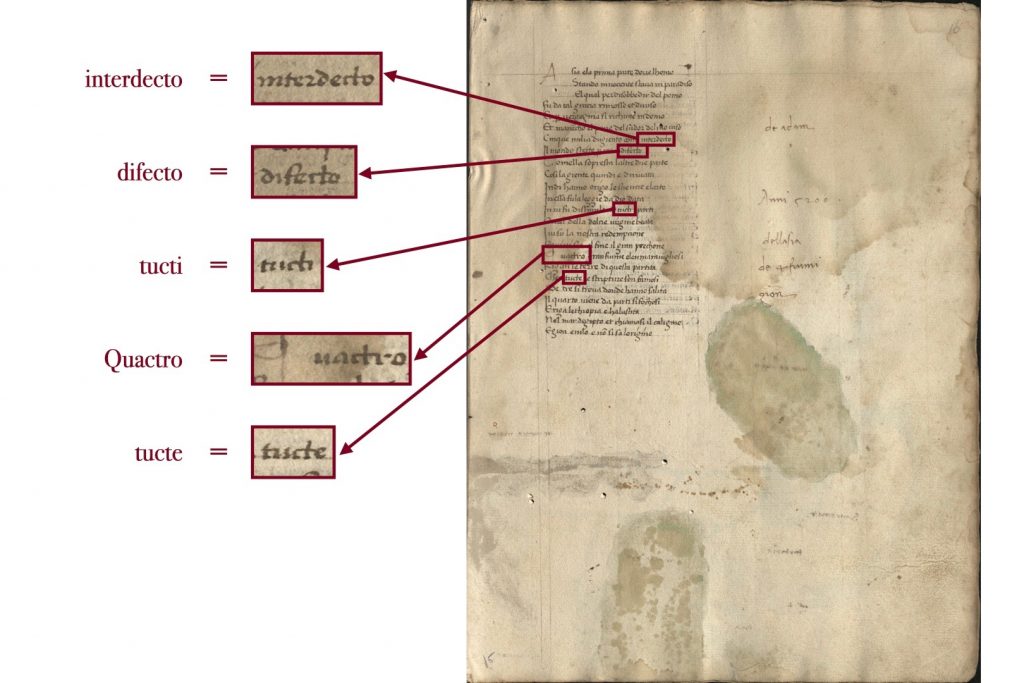
The scribe of Pryce MS P4 also displays some familiarity with the Latin language. For example, the beginning of Book II and Book III are marked with rubrics in Latin: “liber secundus” (book two) and “liber tercius” (book three) on the upper margins of fol. 8r and fol. 14r respectively. This in itself is not indicative of knowledge of Latin, as it was relatively common to use Latin in the rubrics even when the main text was in a vernacular language. The scribe, moreover, in many cases seems to favor spellings in Latin when writing in Italian. For example, they consistently use the Latin form /ct/ instead of /tt/ in the spelling of words, writing “quactro” for “quattro” (four), “octo” for “otto” (eight) and “tucti” for “tutti” (all), etc.
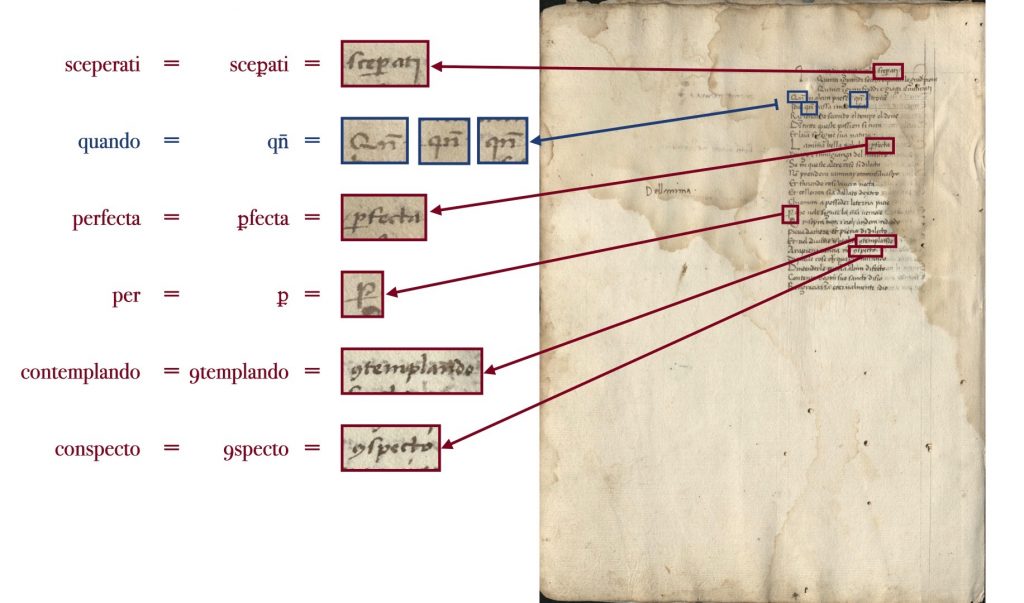
Another significant characteristic of the scribe of Pryce MS P4 is the use of abbreviations that derive from Latin even though the text copied is in Italian. Albeit limited in number, the use of Latin abbreviations is pretty consistent throughout the text, notably the letter p with stroke through its descender representing letters /per/ and the sign resembling the Hindu-Arabic numeral 9 for letters /con/ as well as the combination of the letter q and the letter n with a macron as an abbreviation for the word “quando” (when), which derives directly from Latin.
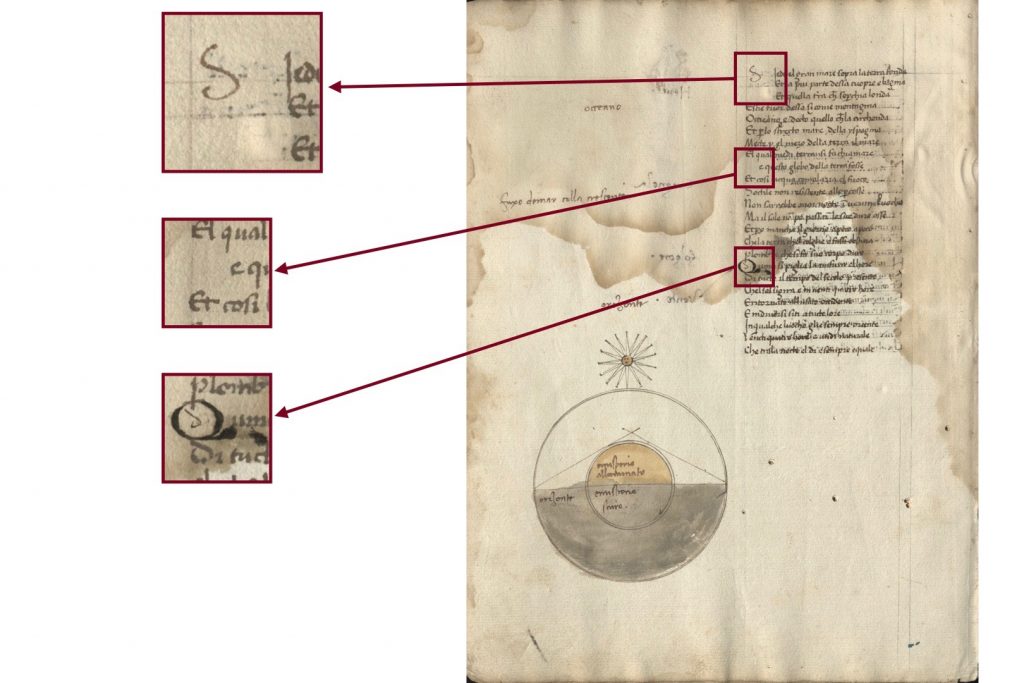
As mentioned, each folio contains 24 lines; i.e., three stanzas. These 24 lines are continuous and there are no spaces left in between stanzas therefore it looks like there are no indications of stanzas in Pryce MS P4. A closer look, however, reveals otherwise. A space was reserved for an initial letter (presumably decorated) at the beginning of each stanza by the scribe. Consistent throughout the manuscript, at the beginning of each folio, there is a 3-line space left for the initial of the first stanza of that folio and a 1-line space for each of the initials of the second and the third stanzas. Thus, either the scribe was aware that the text was in stanzas of eight lines or the exemplar they were using had some sort of division of stanzas.
The decorated initials, however, were never filled in. In most cases, another hand, possibly the one responsible for supplying the rubrics, has supplied the initials in the form of somewhat enlarged letters. Yet, this was not done in a consistent or systematic manner. On fol. 10v, for example, the first initial, the letter S, was supplied in the 3-line space left for the initial of the first stanza, the second initial was completely forgotten and then the third initial was supplied incorrectly as the letter d, only to be corrected later on as the letter Q. In other cases, such as fol. 21, it seems that only guide letters—small letters placed in the spaces provided for initials that indicate which letters are to be added later—were provided. Presumably the guide letters also were inserted by someone other than the main scribe of the text, as their presence is not consistent.
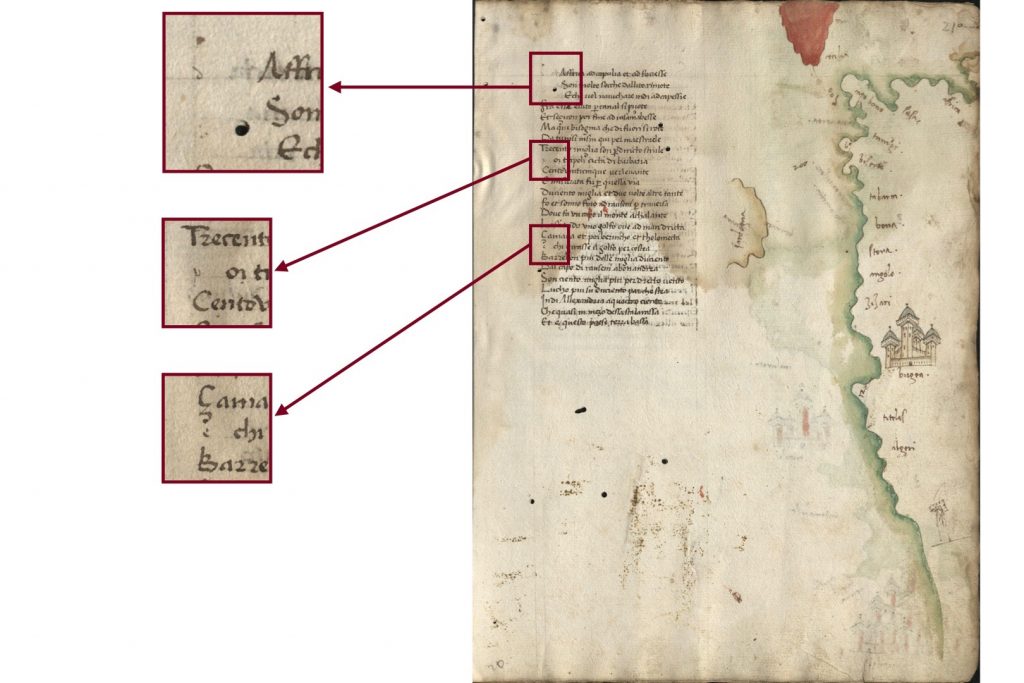
Although there are not a lot of interventions in the main text that can definitively be ascribed to another person, it is clear that others have worked on Pryce MS P4 in addition to our anonymous scribe. Not only are there different strategies for supplying the initials but also the handwriting of the rubrics and the labels of the maps and other illustrations found in the manuscript is markedly different than that of the main text. There may even have been readers leaving their marks on the leaves as there are manicules—symbols in the shape of a pointing hand that are used to draw attention to certain parts of the text—on two separate folios. As we complete our transcription Pryce MS P4 this week, we will surely find more interesting features.
The Kenneth Spencer Research Library purchased the manuscript from H. P. Kraus in 1968, and it is available for consultation at the Library’s Marilyn Stokstad Reading Room when the library is open. In the meantime, you can see more of Pryce MS P4 on Digital Scriptorium and FromThePage.
Read more about Pryce MS P4:
- Karen Severud Cook. “Dati’s Sfera: The Manuscript Copy in the Kenneth Spencer Research Library, University of Kansas.” Mediterranean Studies 11 (2002): 45-70.
- Karen Severud Cook. “La Sfera, A 15th Century Schoolbook.” Inside Spencer: The KSRL Blog, October 19, 2015.
“La Sfera Challenge” website also maintains a wider bibliography on La Sfera and its manuscripts.
N. Kıvılcım Yavuz
Ann Hyde Postdoctoral Researcher
Follow the account “Manuscripts &c.” on Twitter and Instagram for postings about manuscripts from the Kenneth Spencer Research Library.

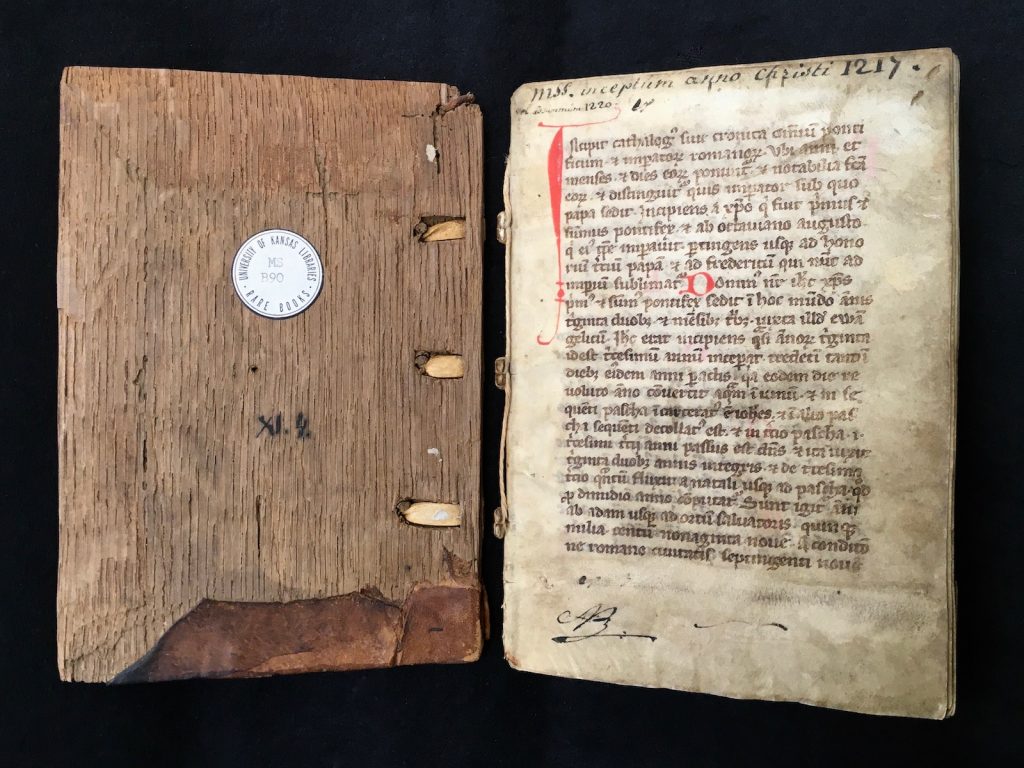
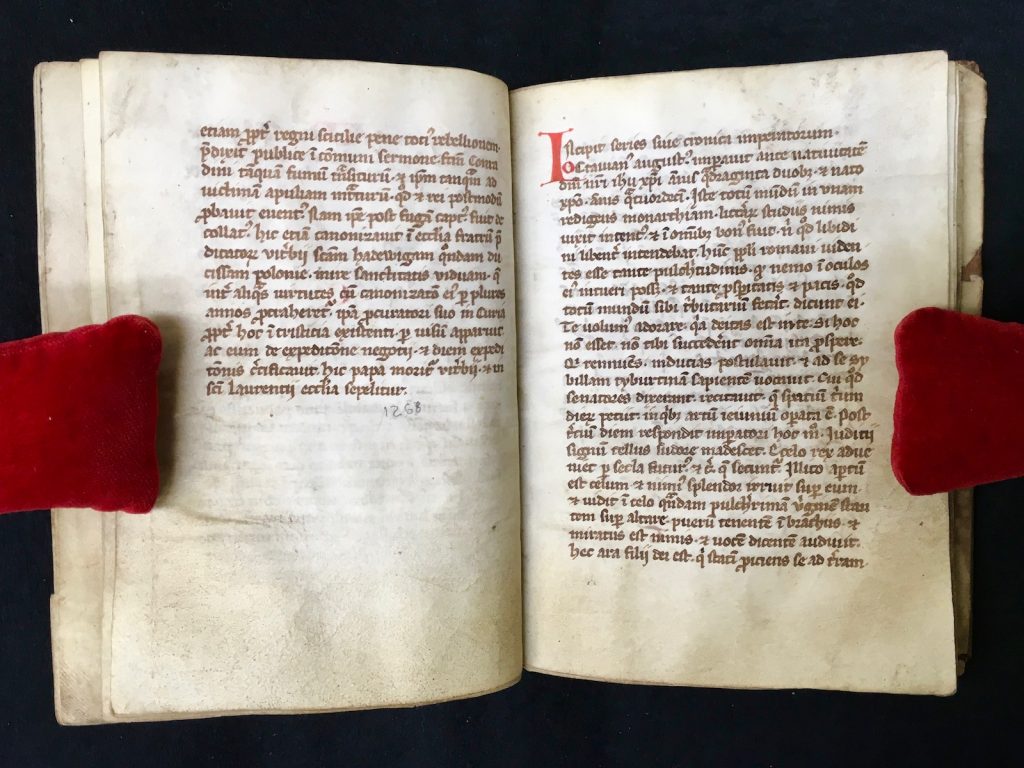
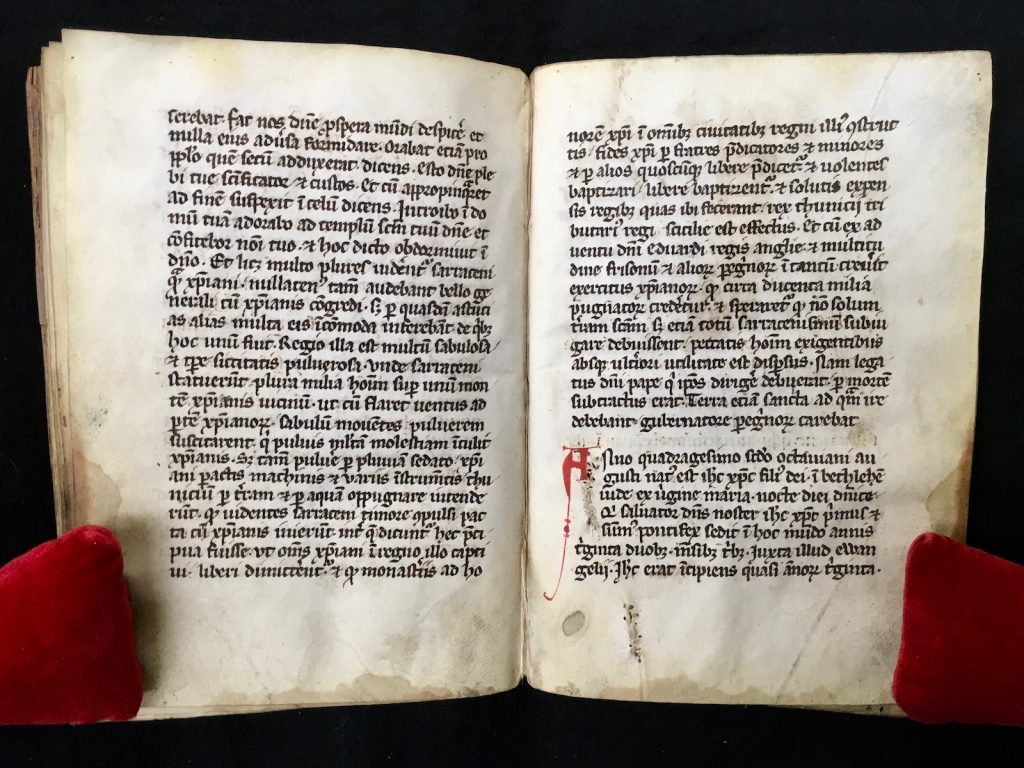
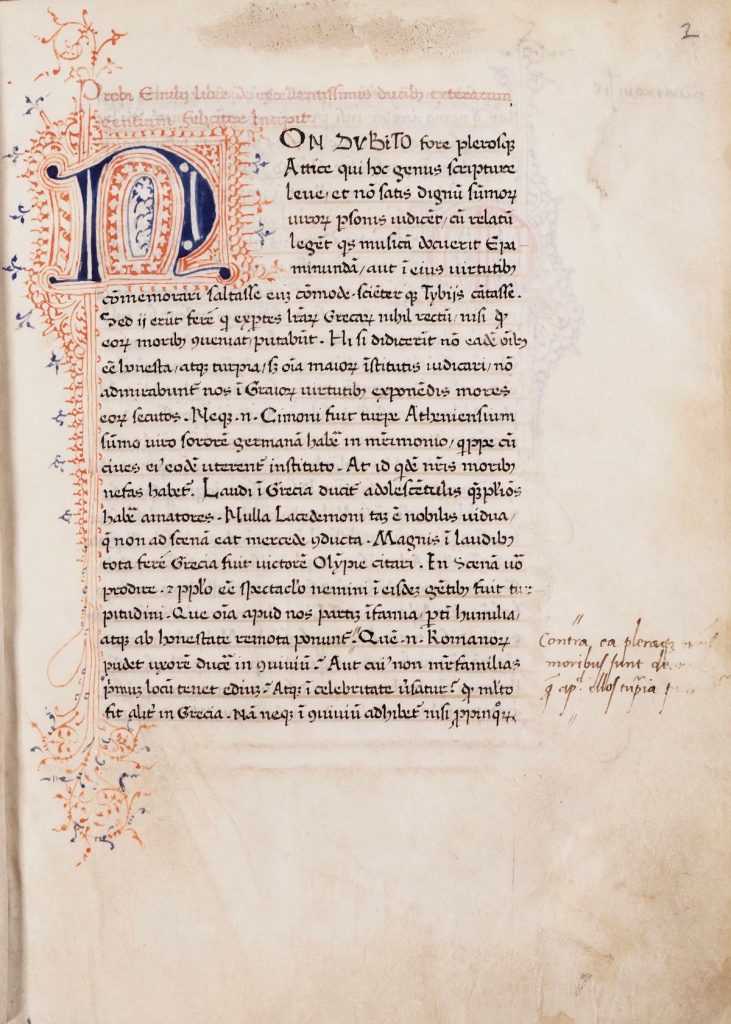
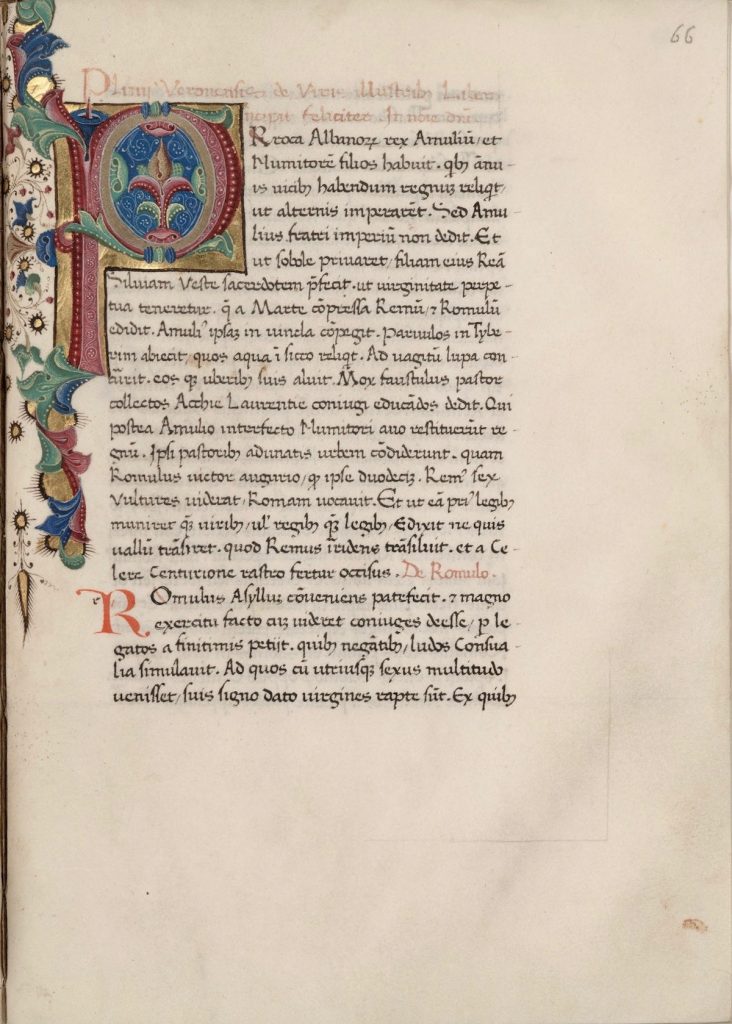
![Image of a manuscript fragment (recto) possibly from Papias the Lombard’s Elementarium doctrinae rudimentum [Elementary Introduction to Learning]. France? Netherlands? 13th century? The fragment had been repurposed as the cover of a codex.](https://blogs.lib.ku.edu/spencer/wp-content/uploads/2020/04/01.-KSRL_MS-9-2-16_folio1r-1024x683.jpg)
![Image of a manuscript fragment (verso) possibly from Papias the Lombard’s Elementarium doctrinae rudimentum [Elementary Introduction to Learning]. France? Netherlands? 13th century? The fragment had been repurposed as the cover of a codex.](https://blogs.lib.ku.edu/spencer/wp-content/uploads/2020/04/02.-KSRL_MS-9-2-16_folio1v-1024x683.jpg)
![Image of a manuscript fragment possibly from Papias the Lombard’s Elementarium doctrinae rudimentum [Elementary Introduction to Learning]. France? Netherlands? 13th century?, digitally processed to enhance the legibility of water-damaged text.](https://blogs.lib.ku.edu/spencer/wp-content/uploads/2020/04/03.-KSRL_MS-9-2-16_folio1r_manipulated-1024x683.jpg)
